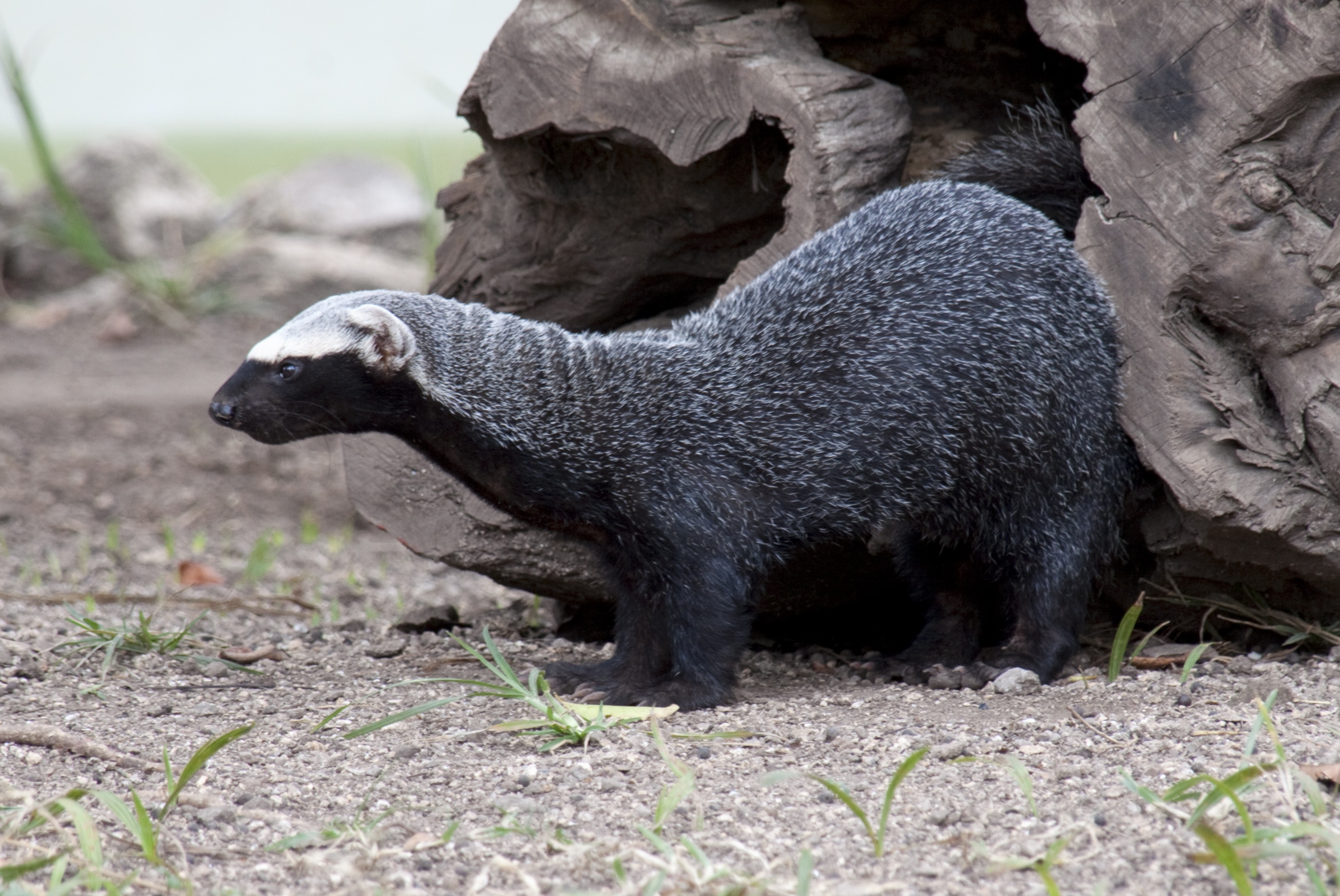A grison, also known as a South American wolverine, is any mustelid in the genus Galictis. Native to Central and South America, the genus contains two extant species: the greater grison (Galictis vittata), which is found widely in South America, through Central America to southern Mexico; and the lesser grison (Galictis cuja), which is restricted to the southern half of South America. In Guyana, we have the greater grison.
Features Of The Greater Grison
- Head – The head is flattened and broad, with short, rounded ears, and dark brown to black eyes.
- Legs – The legs are muscular, with five webbed toes, each ending in a sharp, curved claw.
- Tail – The tail is 14 to 20 centimetres (5.5 to 7.9 in) long, and covered with bushy hair similar in color to that on the animal’s back.
- Weight – Adults weigh between 1.5 and 3.8 kilograms (3.3 and 8.4 lb) in the wild, but may become larger when reared in captivity.
- Color – The back, flanks, top of the head, and the tail, are grizzled grey in color, while the rest of the body is much darker, and usually solid black. A narrow whitish stripe separates the darker and lighter fur on the head and shoulder, but not further back, where the two colors may, in some individuals, blur into one another.
- Appearance – The greater grison is a slender animal with short legs, a long neck, and a short, bushy tail. They are similar in appearance to the closely related lesser grison, from which they can be most readily distinguished by their greater size, with a head-body length ranging from 45 to 60 centimetres (18 to 24 in).
Scientific Classification Of The Greater Grison
Greater Grison – Galictis vittata [Scientific name]
- Kingdom: Animalia
- Phylum: Chordata
- Class: Mammalia
- Order: Carnivora
- Family: Mustelidae
- Genus: Galictis
- Species: G. vittata
There are four living, and one fossil subspecies that are recognized:
- Galictis vittata vittata – northern South America
- Galictis vittata andina – Peru and Bolivia
- Galictis vittata brasiliensis – Brazil
- Galictis vittata canaster – Central America and southern Mexico
- Galictis vittata fossilis – Pleistocene Brazil (fossil)
Habitat Of The Greater Grison
Greater grisons are native to Central and South America (Guyana), ranging from southern Mexico in the north, to central Brazil, Peru, and Bolivia in the south. They inhabit a wide range of forest and cerrado habitats, and are usually seen near rivers and streams. They are typically found at elevations below 500 metres (1,600 ft), but they may be found as high as 2,000 metres (6,600 ft) in some parts of the Bolivian Andes. In some regions, they may also be found in cultivated areas, such as plantations and rice paddies.
Reproduction Of The Greater Grison
Information on the mating system of greater grisons is lacking; however, their close relative, Galictis cuja, may potentially be monogamous.
Young: Litters of up to four young are born from March to September, after a gestation period of 39 days. Newborn young weigh less than 50 grams (1.8 oz), and are initially blind, although with a short coat of hair already bearing the adult pattern. Their eyes open after two weeks, and they begin to eat solid food at three weeks, reaching the adult size in just four months. Female greater grisons nurse their offspring until they are weaned at approximately 3.5 weeks of age. Small groups of grisons observed hunting and exploring together are usually assumed to be mothers with older offspring, indicating that offspring likely associate with their mothers for a certain amount of time post-weaning. They have lived for at least ten years in captivity.
Diet Of The Greater Grison
Greater grisons are carnivores, though they are also quite opportunistic and will eat some plant matter, such as bananas, if offered. In the wild, their prey of choice depends on their specific locale, but in general, they hunt primarily mammals, such as agoutis and opossums. The stomachs contents of wild grisons have also been found to contain amphibians, invertebrates, reptiles, and birds. Grisons have been observed hunting in pairs as well as alone. When attacking prey, greater grisons aim for the back of the head or neck of their prey and bite down hard to kill. In captivity, grisons have been observed holding food items with their forepaws, although they do not appear to use their feet to actually manipulate food items.
Ten Interesting Facts About The Greater Grison
- Greater grisons are primarily terrestrial, although they can climb trees and swim well. They are mostly diurnal, and only occasionally active at night.
- They live alone or in pairs, with home ranges of at least 4.2 square kilometres (1.6 sq mi), and a very low population density, such that they are rarely encountered in the wild.
- They spend the night sleeping in cavities in hollow logs or beneath tree roots, or else in the abandoned burrows of other animals.
- While hunting, they move in a zigzag pattern, making short bounds and occasionally stopping to look around with their heads raised and sniff the air.
- When moving more cautiously, they press their bodies close to the ground in a movement that has been described as ‘snake-like’.
- They have been reported to respond to threats with a series of grunts that rise in intensity and frequency until they become rapid barks, and finally a single loud scream with their teeth bared.
- Grisons also have a wide variety of vocalizations, including: snorting when alarmed or upset, purring when stroked, panting when moving from place to place, squealing during play and barking during aggressive displays.
- Like many other mustelids, greater grisons possess anal scent glands that secrete a yellowish or greenish musk. Although not especially noxious in comparison with that of other species, this can be sprayed at attackers, as well as being used to mark the grison’s territory.
- Greater grisons tend to urinate and defecate in dark corners or nooks, generally using the same location each time. They squat and raise their tails during the act of elimination.
- If raised in captivity from a young age, greater grisons reportedly make affectionate pets. In some instances, they are also kept in captivity for the purpose of controlling rodent populations.
Greater Grison In Guyana
It is a privilege to have these active, smart grisons in Guyana. What makes them even more special are their amazing abilities to swim, climb, make aggressive calls along with other impressive vocalizations. Their cautious snake-like movements and their ability to urinate and defecate in the same location each time reiterates how amazing these creatures really are.
Article References:
- https://en.wikipedia.org/wiki/Greater_grison
- https://animaldiversity.org/accounts/Galictis_vittata/
- https://iwokrama.org/mammals/guides/carn3.html
- https://en.wikipedia.org/wiki/Galictis
- Main Image: By Tony Hisgett – Flickr: Grison 1, CC BY 2.0, https://commons.wikimedia.org/w/index.php?curid=14620953
Discover more from Things Guyana
Subscribe to get the latest posts sent to your email.







